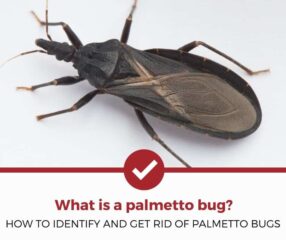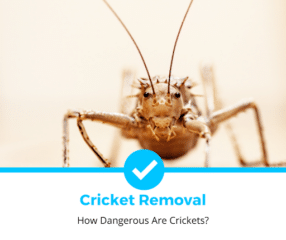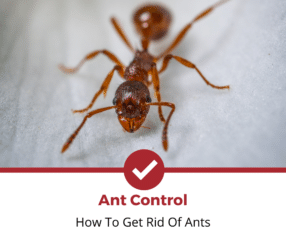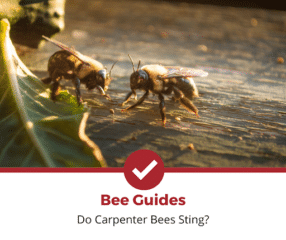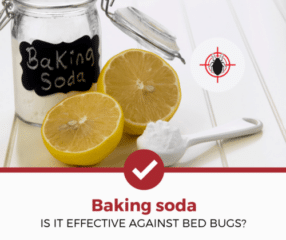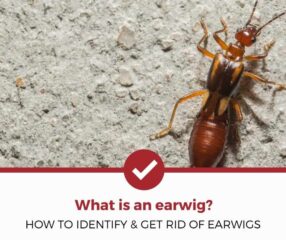What Are Thrips? ( How to Identify & Get Rid of Thrips)
If you’re a grower or a farm owner, you’ll always be on the lookout for dangerous pests. They can cause a lot of damage in a small window of time.
Thrips are among the worst pests that could attack a farm. Thrips attack quickly and they can spread within days. Thrips attack different kinds of crops around the world.
Knowing your enemy and the damage they can make is the best way to beat it. Today, I’ll provide you with the ultimate guide to thrips. So without further ado, let’s dive in!
This Pest Strategies guide covers the following:
- What is a thrip?
- What do thrips look like?
- Are thrips dangerous to humans, pets, or plants?
- What you can do to quickly get rid of thrips

Ed has been working in the pest control industry for years helping 1,000's of homeowners navigate the world of insect and rodent management. He manages Pest Strategies now helping homeowners around the world!

Table of Contents
What Is a Thrip?
Thrips are populous pests that live outdoors. They feed on plants and their saps by sucking. They use their mouthpieces to puncture the outer layer of the host plant.
Thrips are known for attacking gardens, farms, and greenhouses. However, they can also attack indoor plants if they’re able to get their hands on them.
Thrips Origin
Thrips aren’t one genus of insects. In fact, they’re a group of insects that belongs to the order “Thysanoptera”. While most of these thrips depend mainly on sucking the sap of the plants, some of them can be predators to other creatures and smaller insects.
As a result, you might not be able to spot them physically without a magnifying glass or any sort of visual aid. However, you won’t need any of this simply because their presence is noticed in other ways. Once they attack a garden or a farm, their impact is noticed loud and clear.
They suck the nutrients and fluids in them, leading to severe injuries or even death of the plants.
Thrips Reproduction
They can also increase in number significantly in a short period of time, as they can reproduce asexually. This means that females don’t need male partners or sexual intercourse to produce new offspring.
After the attack, they leave these plants with noticeable effects. These effects include:
- Pale or discolored plants
- The scarred outer layer of plants
- Patchy appearance on the plants
- small black excrement specks on the plants
Despite being small in size, their strong impact is easily demonstrated by the power of the group. They scour their area searching for a good source of food, so they can feast on together. This allows them to go through entire fields in a remarkably short amount of time!
This can be a huge blow to the productivity and quality of crops on your farm or greenhouse. Not only that, but they can also carry a lot ofdangerous virusesthat are pathogenic to plants. The most common ones are theTospoviruses, but more on that later.
Take a look at the video below for more information on thrips.
What Other Names Are Thrips Referred To As?
You now know that Thrips is short for the order “Thysanoptera”. The word “Thrip” is a translation from an Ancient Greek word that means “woodworm”. The words “Thysanoptera” is derived from the Greek word “Thysanos”, which means fringed wings.
However, these aren’t the only titles under thrips belts. Since thrips are found almost everywhere. They have a lot of different names accordingly.
Some of these names describe their shape, while others describe some of the crops they’re known to attack. Here’s a list of all the other names that refer to thrips:
- Thunder bugs
- Thunder flies
- Storm bugs
- Storm flies
- Corn flies
- Corn lice
- Corn fleas
- Freckle bugs
- Harvest bugs
- Physopods, which is referring to their old name “Physopoda”
- Terebrantia, which is one of the suborders of the order “Thysanoptera”

Find A Local Exterminator
Are Thrips Poisonous or Dangerous?
Thrips are usually extremely harmful and can be a huge problem if you don’t deal with them as fast as you can. They multiply and increase in number significantly in a very short period of time.
There are two reasons for their quick spreading. The first one is due to asexual reproduction abilities. The other is the lack of competition and natural predators, so they are usually uninterrupted while attacking a garden.
Let’s have a closer look at the harms and dangers that thrips possess against plants and humans.
Dangers and Harms of Thrips Against Plants
The main casualty of thrips is crops andplants.
This section is the most important part to know about thrips. Not only because it shows you their effects, but also because it’s the ideal way to identify them.
Discolored or Pale Leaves
When thrips first attack plants, the leaves start to fold and discolor, as they don’t get their food supply. As a result, they start to darken and fold. They lose their vibrancy and start to turn pale.
After some time, the leaves will start to drop earlier due to the lack of food stock.
The Plants Stops Growing
When thrips attack growing plants, they suck the nutritional sap from the cells. The plant was supposed to use that food sap to grow bigger.
In addition to pale leaves, you can see a noticeable lack of growth upon the infestation of thrips. This includes the size of the plant and the size of fruits and vegetables you’re growing.
Fruits and Vegetables Get an Obvious Low Quality
You know that Thrips can render the fruits and vegetables smaller. However, they also give them a discolored or darkened finish.
你现在知道, thrips leave their excrement on the plants. These tiny black specks make them unappealing to eat. Although the internal parts might still be intact and edible, the outer layer would be extremely uninviting to customers.
Flowering petals also become darkened with black specks, which makes them a huge problem for florists and flower gardeners as well.
Farmers won’t be able to sell the discolored plant leaves and unappealing fruits and vegetables. Thrips can cause general lower productivity of the garden, as they can hinder the plants’ growth.
Even worse, by spreading plant diseases, they can cause even more financial losses.
Spreading of Pathogens and Plant Viruses
Some species of thrips aren’t only harmful because they suck the sap out of the plant. These species act as carriers for a large selection of plant viruses. The most significant viruses are:
- Tospovirus
- Ilarvirus
- Machlomovirus
- Sobemovirus
- Carmovirus
These viruses cause serious diseases andinfections to the plants. They usually require expensive treatments as well.
Some of these viruses are transmitted during the larval stage of thrips, which I’ll be talking about later. However, thrips can transmitTospovirusthroughout their life.
Stops the Photosynthesis Process
The photosynthesis process is the process in which green plants utilize sunlight to make their nutrition. With thrips eating off all the green parts of the crops, the pants won’t be able to do the process.
This stops the plant from making its own food, which eventually leads to the death of the plants by starvation.
Plants Become Unable to Reproduce
你现在知道, thrips feed in large quantities and they eat all parts of the plants. This means that they’re going to go through the flowering buds, which are the plants’ reproductive organs.
By eating them off, these plant buds might be deformed beyond functionality. This prevents them from opening in their flowering season. As a result, they won’t be able to pollinate and reproduce.
A Note About The Benefits of Thrips
Not all thrips are harmful! In fact, some of them can be good for the environment. Some species of thrips are predators of other smaller insects. This includes blood-sucking mites. Also, the non-harmful species contribute to the pollination of plants.
Dangers and Harms of Thrips Against Humans
Thrips can be a huge burden for humans even though we aren’t their main target. We all know that thrips are dangerous for farmers for all the previous reasons.
But can thrips be directly dangerous to humans? Let’s find out!
Thrips can Bite!
There are a lot of ways to get exposed to thrips. You can be a farmer walking in his farm barefooted. You can also be using bare hands to work in your garden. However, you should be careful because thrips can bite.
通常,大多数害虫咬进人类皮肤而大海rching for moisture. They don’t have to be deliberately biting you, as they’re usually exploring their surroundings using their mouthparts. Disturbing the thrips can also be a reason for them to bite you.
If the infected plants are in your backyard garden, thrips can fly around searching for more food, so they can enter your house.
Thrips can also feed on houseplants if they can reach it, so that’s another reason for them to be at your home.Thrip bitesusually causes some irritation to your skin. It goes without saying that you should remove the indoor plant if they attack it.
However, this irritation is minor and doesn’t cause bite marks, swelling or dangerous rash. They also don’t last for long, so you don’t have to worry about them that much unless you’re allergic to bug bites. In that case, you should visit your doctor immediately.
Human Infestation and Infection
According to some studies, thrips can infect human bodies in certain circumstances. Scientists found an adult female corn thrip infesting a fungus-infected toenail of a human. They also found that thrips can accidentally enter the human body through the nose and ears.
All these cases are extremely rare as plants are their main target. However, they’re still possible as accidents
Claims of Further Infestations
If thrips find their way into your house, they might stick around looking for food, they might infest your wood furniture in the process as well.
Financial Losses
The grower will have to spend a lot of money to treat the plants from the diseases caused by the thrips.
The earlier you eliminate thrips, the less money you’ll have to pay in the process. Yet, thrips are extremely tiny, so growers notice thrips’ presence by their effect on crops.
This is relatively late and requires more funds to be done. All these expenses, especially on commercial-scale greenhouses, take a lot from your final profits.
As you can see, a farm owner has to spend a lot of money to get rid of them. This means that it’s more financially wise to prevent them all-together.
What Do Thrips Look Like & How Do I Identify Thrips?
The identification of thrips is a bit tricky for a lot of reasons. First of all, They’re extremely tiny in size, which is about1 millimeteror less sometimes. However, there are some species that reach up to 14 millimeters.
Additionally, they have thin bodies and small fringed wings. Thrips aren’t great at flying because their wings aren’t strong. They depend on a mechanism called “clap and fling”.
According to most resources, There are about 6,000 confirmed species of thrips around the world.
They come in different colors ranging between black, yellow, brown, and white. However, there are some species that have red and orange bodies.
Being extremely tiny, you can’t identify them simply by looking. That’s why they’re identified by their symptoms, which I discussed thoroughly above.
What Are Thrips Commonly Mistaken For?
There are different pests that can have some similar effects to thrips. Also, some insects might be similar to thrips but have a much different effect on the plants.
Here’s a comparison list between thrips and other pests that thrips are commonly mistaken for.
Thrips Vs. Aphids
Aphidsare among the most popular plants’ pests worldwide. They share a lot of common characteristics with thrips to the point that some might think that they’re both the same.
However, they’re two different insects. Aphids are also extremely small insects that infect various plants and crops. They also use their mouthparts to suck on cell sap content.
They’re known as blackfly or the greenfly, which shows their color diversity across different species. Aphids usually live mainly in warmer climates.
They’re a member of the Aphidoidea family, hence the name. Unlike Thrips, aphids have pear-shaped bodies and vary in color significantly. They also don’t have wings.
On the other hand, thrips are winged with slender bodies and an elongated last body segment. They’re usually darker in color.
Thrips Vs. Springtails
Another pest that might be mistaken for thrips isspringtails. First of all, springtails aren’t considered insects. The reason behind that is that springtails don’t have external mouthparts.
他们没有wings. Instead, springtails move by jumping. Also, they don’t feed on plants, as they’re more into decaying matter than living nutrition.
They don’t pierce plants to feed on its sap as thrips do. Springtails feed mainly on spores and stalks of fungus. However, they can eat some bacteria, plants, or animal materials.
他们通常小于6毫米长。这意味着y’re remarkably larger than thrips. That’s why it’s possible to tell springtails from thrips just by looking.
Thrips Vs. Spider Mites
Spider mitesand thrips can be hard to tell from each other. First, spider mites don’t have wings and can’t fly. On the other hand, some species of thrips use their wings to fly.
Spider mites produce webbing, which is why they’re called spiders in the first place. If you find webbing under leaves, you most likely have spider mites and not thrips.
As you can notice, spider mites usually live under the leaves. Thrips prefer to live on top of the leaves.
Apart from the symptoms, both spider mites and thrips share a slender body of about 1 millimeter on average. That’s why it’s difficult to tell them apart judging by the appearance, unlike springtails or aphids.
Read More:How to Get Rid of Spider Mites


